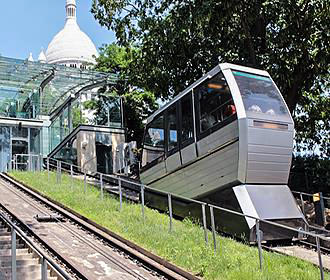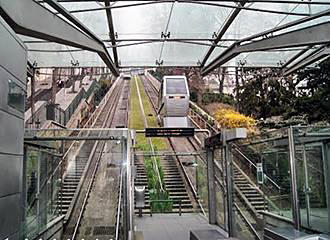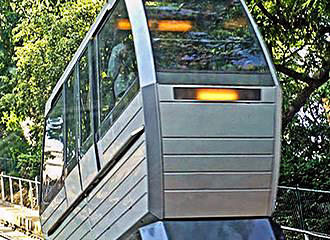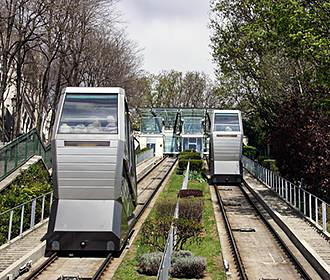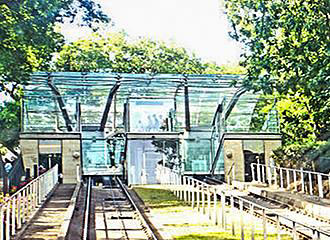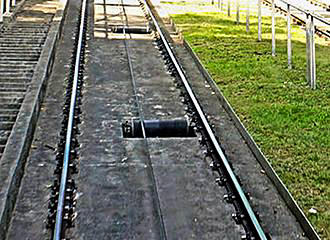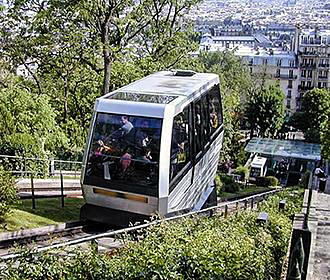The Paris Montmartre Funicular
In French the Paris Montmartre Funicular is called the Funiculaire du Montmartre and it will take you from near the bottom of the Montmartre hill to near the top and a short climb up some steps from the station brings you to the Sacre Coeur Basilica along with other places like the Saint Pierre church and Place du Tertre.
Paris Montmartre Funicular History
It was way back in 1891 that the Paris government decided that they wanted to have funicular built, so that people could get up and down Montmartre easily, whether it be for worship or those that were living in the area.
The original the Paris Montmartre Funicular was water-powered and used a system of cisterns that were either filled or emptied to move the cars up or down, which did mean they had to also compensate for when these were loaded with passengers, which at the time was within stepped compartments.
The running of the Paris Montmartre Funicular was subcontracted to the Decauville company through a concession and running alongside the Rue Foyatier, the Funiculaire du Montmartre was first opened in the July of 1900, however the Decauville contract for this would only run until 1931.
Now a funicular is often referred to as a cable car railway, and when the contract on the Paris Montmartre Funicular expired, the running of this particular option of Paris public transport up and down Montmarte was put in the hands of the STCRP.
However, by this time, the initial system was deemed to be dangerous and it was then closed down late in the year of 1931. But the company had already been given the task of not only running this transport service but modernising it where necessary, and so they set about completely changing the type of system used.
The original water driven system was replaced by two electrically driven cabins and the traction was provided by a winch driven electric motor, that also allowed each cabin to hold approximately 50 people. Also the short journey was far easier and comfortable as each of the two cabins just had one large compartment, rather than being like a staircase, as in the original design.
After these major renovations and improvements that included work on the lower station between the Place Saint-Pierre and the Place Suzanne-Valadon along with renovating the upper station, eventually the Funiculaire du Montmartre was re-opened again in the February of 1935.
Which was a great relief for the people who had businesses or lived in the area, that this form of transport in Paris was up and running again, and even when the STCRP was nationalised along with another company and they were merged together, the service still continued.
Now this new company is known by the initials of RATP, which stands for Regie Autonome des Transports Parisiens and this is the company that provides virtually all Paris public transport such as the Metro and the Paris buses including the Montmartre Bus as well.
However, after being in operation for over fifty years the Paris Montmartre Funicular was in need of renovation again, so yet again the operation of the funicular stopped in 1990 but a temporary bus service took over. And in fact this substitute service was the Montmartre Bus service, that is still going today, as it was such a success for an alternative means of transport up and down Montmartre.
The old Paris Montmartre Funicular stations were completely demolished and the new design chosen was by the architect Francois Deslaugiers who had the great idea that the stations would be see through stations, which meant the main material would be glass.
The new cabins were designed by the industrial designer Roger Tallon and these would have large glass sections and partly glazed roofs to give great views, so that you can get a view of the Sacre Coeur Basilica or the panorama as you are travelling up or down on the Paris Montmartre Funicular.
When it came to the actual funicular itself, the work was carried out by the Schindler Group, who are major lift manufacturers and the technology used was derived from standard lifts, which allows the cars to run independently.
So today it is not really now a true funicular in a sense, as a funicular system would normally rely on one car being a counterweight against the other, and the Paris Montmartre Funicular now utilises angled lift technology with electric traction and its own hoist and cables, that makes each car independent.
However, it does mean that if one car needs to be serviced, the other can still run, and it is also beneficial for the tourist season when the area gets extremely busy with the amount of people visiting here whilst on holiday in Paris, as both cars can also ascend at the same time.
The machinery that makes this all possible is housed in the upper station which holds two incredibly powerful winches, and with the cabins weighing around 6 tonnes each not loaded, they do need to be powerful! but they also now have a service brake and an emergency brake, as well as system being fully automatic.
Being put back into service in 1991 after the major renovations, they are still operated by the RATP company and have only had one interruption in service since, which was after an incident in 2006 that meant the Paris Montmartre Funicular had to close and it was not re-opened again until the following year.
About the Paris Montmartre Funicular today
At 108 metres long, the Paris Montmartre Funicular climbs and drops in under a minute and a half and for the last few years it has carried over 2 million passengers each year, yet incredibly, each car can only carry a maximum of 60 passengers at a time.
As mentioned before, the Montmartre Funicular runs alongside the Rue Foyatier, which is generally like a wide staircase with over 200 steps, but by using this form of transport means that the pilgrims going to the Sacre Coeur or the tourists visiting this monument in Paris do not have to negotiate around 300 steps!
It is open every day from 6am until just after midnight and is the same cost as a Metro ticket, which is approximately €1.70 as of 2012 plus runs every few minutes. However, there is no direct transport interchange, except with the Montmartrobus, that stops in the Rue du Cardinal-Dubois in front of the upper station.
But you can easily access two different Metro stations, which are called Anvers and the Abbesses, that are located around 300m from the start of the Paris Montmartre Funicular.
Obviously, because the cars can only hold so many passengers at a time, during the summer holiday season and at special times of the year like Easter, then the queues and the waiting times for the funicular can be quite long, so do bear this in mind if you do not want to walk up all those steps.
Mind you, a lot of people do walk down from the top of Montmartre rather than waiting around for a ride and that is a lot easier going. Yet even if you have young children with you and feel that this would not be one of the best places to visit, you could think about the France Miniature theme park, which is literally a model of Paris, and even here they have a model of the funicular railway by the Sacre Coeur Basilica, as this is now classed as one of the Paris landmarks.
Montmartre Funicular tramway map for Sacre Coeur Basilica
The Paris Montmartre Funicular was originally installed to allow easier access up the hill to Sacre Coeur Basilica and used to be a counterbalance system, and although the cars work independently today, it has still retained its original name of Funiculaire de Montmartre, and here you can see a map showing the location of this Paris public transport system including the Gare Basse and top stations.
Montmartre Funicular main transport connections within 550m:
Metro Lines: 2, 12.
Bus Lines: 40, 54, 85, N01, N02, Open Tour, BigBus.
Paris Montmartre Funicular plans available:
Montmartre Funicular plan - PDF (5.746 MB - with links to all transport maps)
Montmartre Funicular plan - Image (2.617 MB)
